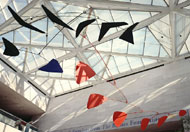
 Alexander Calder's 76-foot-long mobile, the icon of the Gallery's
East Building that has gracefully presided over its central court
for twenty-seven years went back on view June 7, 2005, after undergoing conservation
treatment. National Gallery staff and engineers, including artist-engineer
Paul Matisse, the grandson of Henri Matisse and a close friend
of Calder's, disassembled the 920-pound sculpture in April 19, 2004 so
that its multicolored parts could be cleaned and its metal surfaces
repaired. At the same time, work is being done on the hanging
mechanism that is secured to the atrium roof. More than forty
staff members are involved in the numerous stages of this extensive
project.
Alexander Calder's 76-foot-long mobile, the icon of the Gallery's
East Building that has gracefully presided over its central court
for twenty-seven years went back on view June 7, 2005, after undergoing conservation
treatment. National Gallery staff and engineers, including artist-engineer
Paul Matisse, the grandson of Henri Matisse and a close friend
of Calder's, disassembled the 920-pound sculpture in April 19, 2004 so
that its multicolored parts could be cleaned and its metal surfaces
repaired. At the same time, work is being done on the hanging
mechanism that is secured to the atrium roof. More than forty
staff members are involved in the numerous stages of this extensive
project.
Calder created his first moving abstract sculptures or "mobiles" in the early 1930s. Using an ingenious system of weights and counterbalances, he eventually designed constructions that moved freely when suspended, powered only by slight air currents. The work he created for the East Building, Untitled, 1976, is by far the largest example of this type of motorless construction.
In 1972, when the East Building was still under construction, Calder was asked to create a large mobile that would visually anchor the structure's monumental atrium. Originally planned in steel, the sculpture's thirteen panels and twelve arms were too heavy to function as the artist intended. Paul Matisse translated the design into an aluminum construction that retained the look and dynamism of Calder's original maquette. The mobile is now constructed of aluminum honeycomb panels, hollow aluminum tubes, and very little steel. Calder's last major work of art, it was installed on November 18, 1977, one year after his death.
On view in the National Gallery's East Building, Ground Gallery 100 Ceiling.


